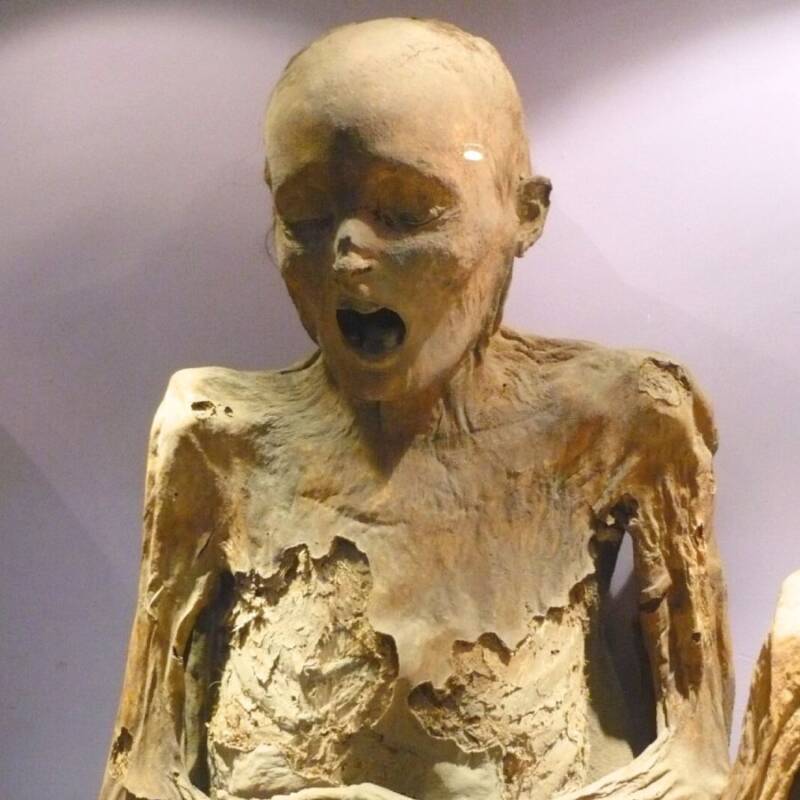One of the Guanajuato Mummies on display at a tourism fair in Mexico City reportedly showed signs of "fungal growths" — and the glass case it was in may not have been enough to stop the spores from spreading.

Wikimedia CommonsOne of the mummies on display at the Museo de las Momias in Guanajuato, Mexico.
Mexico’s National Institute of Anthropology and History has warned that a traveling display of 19th-century mummies may have the potential to spread a dangerous fungal infection to visitors who view them.
The mummies, which are typically on display at the Museo de las Momias (Museum of the Mummies) in Guanajuato, date back to the 1800s. Then, they were buried in crypts surrounded by dry, mineral-rich soil, and the bodies unintentionally became mummified. Decades later, a newly-introduced burial tax meant that some of the families of the deceased could no longer afford to keep the bodies interred. When workers exhumed the corpses of those whose descendants didn’t pay up, they were shocked to find them largely intact.
Many of the mummies still have hair, skin, and even the clothes they were buried in.
Because of the impressive state of their bodies, the mummies became a sensation in the early 1900s. The mummies’ owners often changed the expressions on their faces to resemble shock and horror to appeal to the “scary” mummy trope that was first introduced by Sir Arthur Conan Doyle in his short story “Lot No. 249” in 1892.
This altering and display of the mummies sparked criticism from many observers who thought the treatment was disrespectful and dehumanizing.
“These are just regular people who are repositories of information about the period they lived in,” Gerald Conlogue, a diagnostic imaging professor at Quinnipiac University in Connecticut, told National Geographic. “They walked these streets; they went to the old market. They shouldn’t be a freak show.”
But a freak show they became. The mummies have traveled frequently, appearing at tourism fairs across Mexico and even going on display in the United States in 2009.
Now, after seeing photos of the mummies from their most recent stint at a fair in Mexico City, experts at the National Institute of Anthropology and History worry they may be exposing visitors to dangerous fungal spores.

“From some of the published photos, at least one of the corpses on display, which the institute inspected in November 2021, shows signs of a proliferation of possible fungus colonies,” said the institute, as reported by the Associated Press. “It is even more worrisome that they are still being exhibited without the safeguards for the public against biohazards.”
While glass casing separates the mummies from viewers, experts warn it may not be airtight. Gaps in the glass could allow dangerous fungal spores to seep out into the air that visitors breathe.

Wikimedia CommonsThe mummies are so well-preserved that some are still wearing the clothes they were buried in.
Although experts did not state what kind of fungal growths the mummy had, they warned that they could pose serious health risks.
“[The mummies] should all be carefully studied to see if these are signs of a risk for the cultural legacy, as well as for those who handle them and come to see them,” the institute added.
This incident with the Guanajuato Mummies isn’t the first time preserved corpses have posed a health risk to humans who came into contact with them. Many believe the excavation of Egyptian pharaoh Tutankhamun’s tomb may have unleashed deadly spores. More than 20 people who were involved in the discovery of his burial place died shortly after, sparking rumors of a “curse.”
According to IFLScience, the fungus aspergillus may have been the culprit. It is capable of surviving for long periods of time in dark areas, like tombs.
In 1970, a similar event occurred when 12 scientists opened the tomb of King Casimir IV of Poland. Within weeks, 10 of them had died. Researchers still aren’t sure which fungus was the likely assailant, as they collected several cultures from the tomb.
Evidently, business with the dead is wrought with many dangers. For those interested in viewing the remains of those who lived long before us, remember to approach with caution.
You never know what kind of “curse” could be lurking in the air.
After reading about the Mexican mummies that may be spreading fungal infections, learn about cordyceps, the fungus that turns insects into zombies. Then, uncover the chilling stories of nine mummies around the world.





